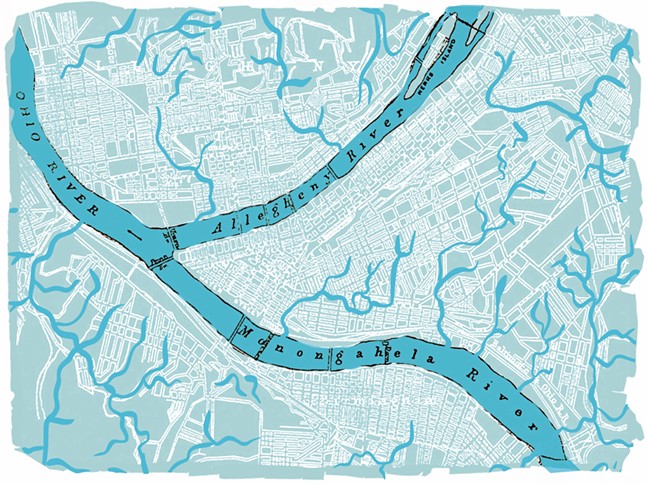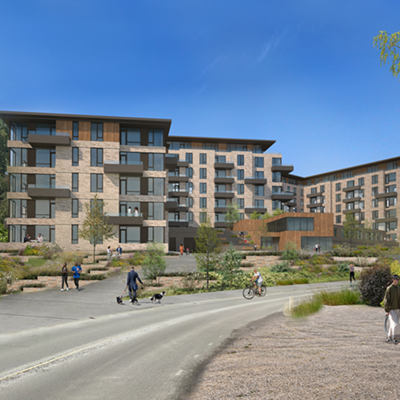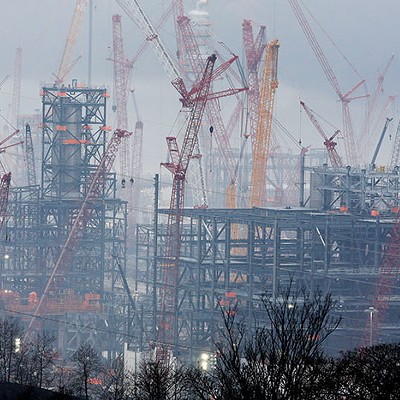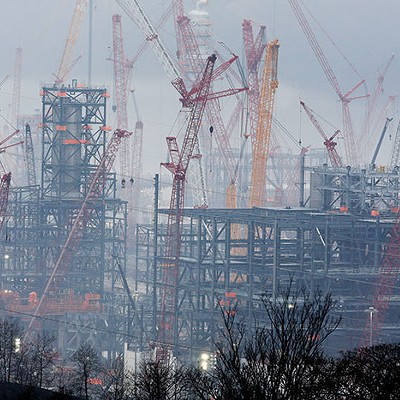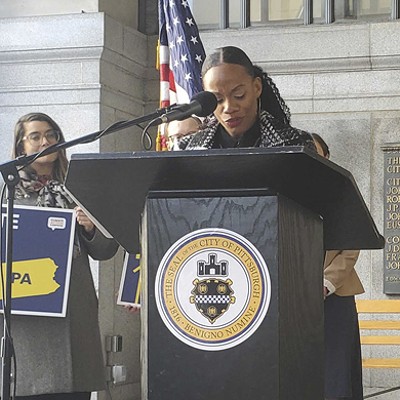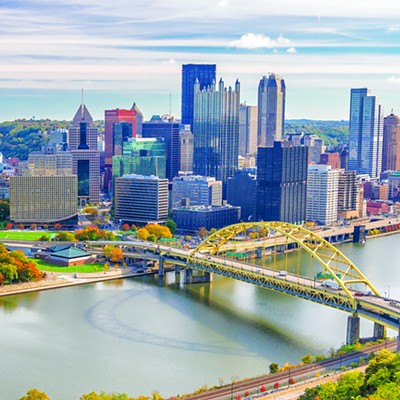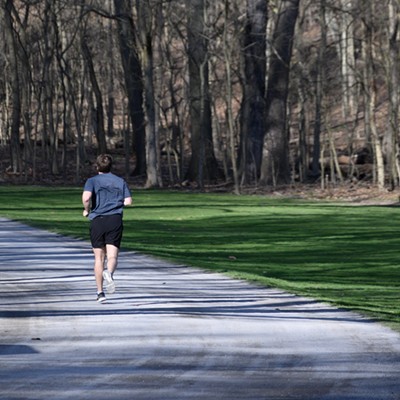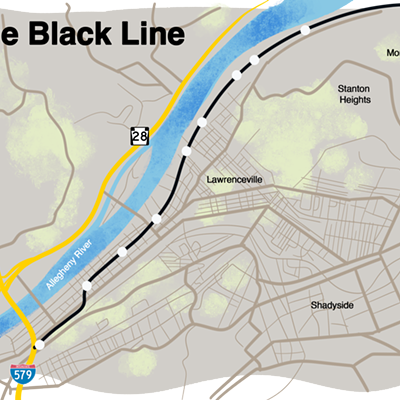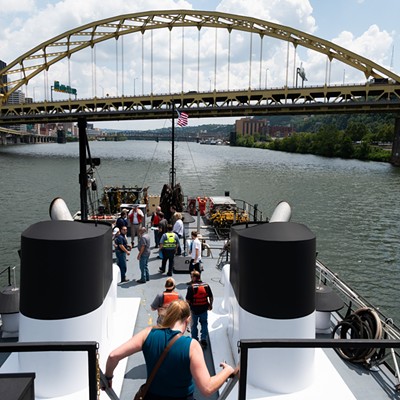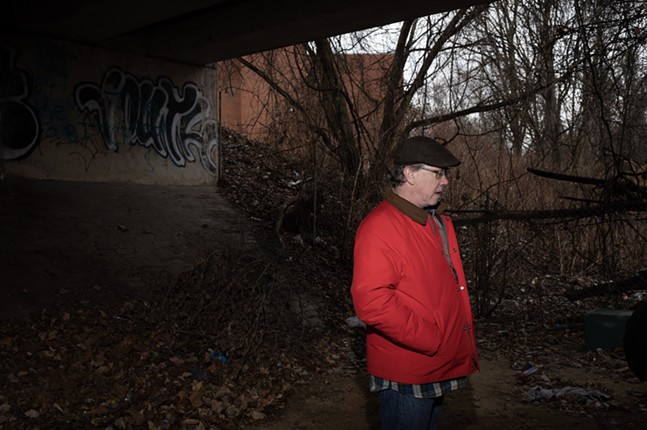
The city's hidden waterways range in size from seasonal trickles to continuously flowing brooks with their own small watersheds. Many of them now serve as part of the city's stormwater and sewer network. In spite of that, environmentalists and some local officials see potential in these covert culverts. Beyond making for attractive greenspaces, they have the potential to absorb Pittsburgh's expected increase in rainfall thanks to global climate change.
"I don't think a lot of people realize there are stream networks cutting beneath our streets and backyards," Mike Hiller, executive director of UpstreamPgh, tells Pittsburgh City Paper. UpstreamPgh, previously the Nine Mile Run Watershed Association, is a nonprofit focused on "stormwater problem-solving" and restoration of local streams.
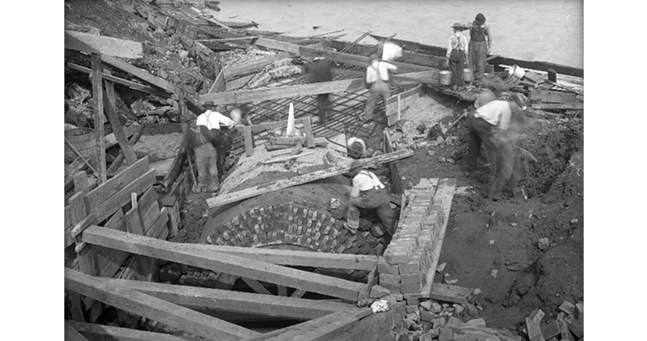
Putting streams underground was an early approach to sanitation and flood control in a region with an abundance of water. "Streams created flooding, so there was an element of more safety by putting in pipes," Hiller says. Burying streams was the "accepted methodology at the time." That's changed — environmentalists now see benefits to daylighting, or bringing buried streams back to the surface, as well as other, greener approaches to the city's overabundance of water. Local projects, including UpstreamPgh's lauded restoration of Nine Mile Run, show that there are environmental, recreational, and practical benefits to daylighting streams.
However, most of Pittsburgh's channelized creeks are directly beneath some of the city's densest development and inextricably tied into the sewer system, occasionally leading to combined sewer overflow (CSO) that dumps raw sewage into the three rivers. These issues have forced local environmentalists and policymakers to get creative with how they think about water as the city seeks a greener future.
What runs beneath
Pre-colonial Pittsburgh would have likely looked much like a state park. What's now the Golden Triangle was a small slice of floodplain cut through by creeks and seasonally sculpted by the rivers' cyclical ebbs and flows. The Monongahela and Ohio were shallower before locks and dams regulated water levels, and part of what's beneath the infamous I-376 "Bathtub" would have been a small island separated from the riverbank by shallow water. Supporting some of the oldest Indigenous settlements on the continent, the area's rivers and runs were lively fisheries for tribes such as the Osage and Seneca.
Following brief French and British periods of occupation, the settlement around Fort Pitt formed the nucleus of contemporary Pittsburgh. George Washington's map from the era shows a prominent creek flowing through the modern-day North Side. After growing into a small transportation hub for voyages west, Pittsburgh's first major industry was boatbuilding. One must imagine the abundant fresh water was also a helpful resource in the area's numerous distilling operations during the time of the Whiskey Rebellion.
The discovery of iron and coal at the beginning of the Industrial Revolution catalyzed rapid growth. As the city grew, however, these waterways went from water sources to open sewers to topographical nuisances. Particularly in the late-19th and early-20th centuries, the many small runs cutting through burgeoning neighborhoods were often buried to create more land for housing, as was the case for Heth's Run (or Haight's Run on older maps) in East Liberty and Highland Park.
In the early 20th-century, "the city filled Heth's Run with millions and millions of cubic yards of incinerator ash from an incinerator somebody operated over on Herr's Island," David Hance, president of the Highland Park Community Development Corporation, tells City Paper. "It's one of those repercussions of the haphazard addressing of stormwater runoff and sewer flows that were slapped together, and then, 100 years later, we all live with the results without understanding why they are the way they are."
He notes that the bridge carrying Route 8 between Baker St. and One Wild Place is a relic of an unrealized plan by Edward Manning Bigelow to connect the city's parks and the scenic byway of Allegheny River Blvd. Instead of a grand entrance to Highland Park, however, the bridge now overlooks the vast, impermeable parking lot of the Pittsburgh Zoo & Aquarium.
Hance has been working for "decades" to "address the many problems of the current Heth's Run." The upper portion of the stream now flows beneath Heths Ave. and a green space choked with invasive plants. Other Pittsburgh street names are clearer in indicating what lies beneath: Woods Run Ave., Negley Run Blvd., and Four Mile Run Rd. all overlay their namesakes, which environmentalists say is precisely the problem.
Playgrounds, trails, and bioswales
John Stephen stands under a low overpass in a passageway filled with crushed cans, discarded condoms, and hardy weeds. The traffic of East Liberty Blvd. is audible above. Stephen is standing at roughly the spot where Negley Run, once one of the higher-volume Pittsburgh tributaries of the Allegheny, once flowed. Its watershed drains much of the contemporary East End — and occasionally floods with deadly results, a result of putting the stream into a pipe that's not big enough to handle heavy rains.
Stephen says daylighting could help prevent further disasters. "We need to do a better job of managing stormwater. And part of that equation would be to let the stormwater flow on the surface like it once did," he tells CP.
Stephen is the strategic coordinator for the Southwestern Pennsylvania Water Network. Behind him is one of the projects he and others see as part of the solution to the heavy rain the city has experienced in recent years. In contrast to the trash-choked underpass, Liberty Green Park has a spacious playground, an interactive art component featuring a groundwater pump, and several bioswales, essentially wide areas of lower land planted with reeds where stormwater can collect and filter down through the surface soil back into the groundwater, or, in this case, Negley Run.
"One thing that I've kind of tried to encourage is, if there was a way we could identify this path of an urban stream, [we should] reflect that on the surface in some way [and] remind people of that connection," Stephen says. He's hopeful a bigger park project will see more of the stream daylighted alongside a park benefitting Larimer residents.
Pittsburgh City Councilmember Erika Strassburger (D-8), who also serves as vice-chair of Pittsburgh Water and Sewer Authority's (PWSA) board of directors, says she's seen an "evolution" in thinking around these buried streams, which she notes are common to many industrial cities in the eastern U.S. "The approach [in the past] had been, let's just build big tunnels, and then engineering grid infrastructure will solve everything," she tells CP. Strassburger says Negley Run is one of the worst sources of CSO during heavy precipitation.
Projects like the restoration of Squirrel Hill's Wightman Park in Strassburger's district represent a move back toward greener infrastructure. Strassburger won the 2023 U.S. Water Prize for Outstanding Public Official in part for her work on adding bioswales and an underground cistern, which collect rainwater, to what had previously been a soggy ballfield. The city also recently received national commendation for its proactive approach to stormwater.
Strassburger says bioswales can stand in for daylighting where density makes that process difficult, and can be included in traffic-calming projects such as the curb bump-outs feeding Wightman Park's cistern. She's hopeful that PWSA's recently released Stormwater Strategic Plan, which included extensive community input, will bring more awareness around Pittsburgh's efforts to manage heavy rains and flooding problems.
"I think it's incredibly important not to have … a top-down, bureaucratic approach to solutions," she says.
Future flows
Obstacles remain, the biggest being the sheer cost. Some buried runs flow beneath major business districts, as does Soho Run, which once flowed beneath the Centre Ave. corridor in the Hill District. One map by engineer Tom Batroney shows numerous smaller creeks underneath the streets of Lawrenceville, Hazelwood, and the South Side. Heth's Run now flows mostly beneath the vast parking lot of the Pittsburgh Zoo & Aquarium — the zoo recently covered a gravel overflow section of the lot with asphalt, creating an even larger impermeable surface in the old stream bed.
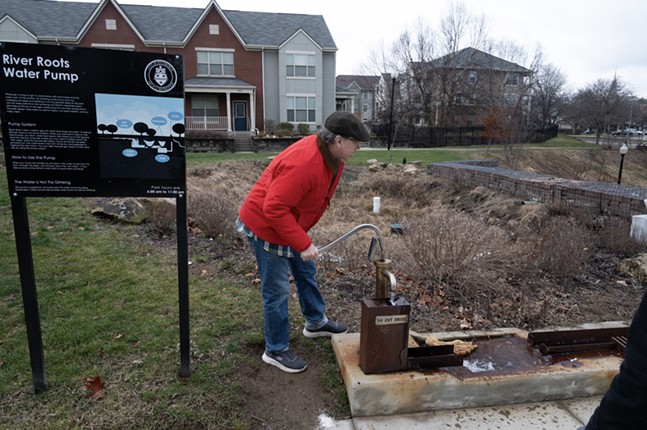
Hance remains hopeful that stalled plans to daylight the stream will move ahead. The challenge is getting the city, zoo, Parks Conservancy, and PWSA to agree on a solution, funding, and timeline. "It's a mile-long valley from Hampton St. out to the waterfront, and so it's a tremendous resource," Hance says. "It could be so much better."
Other unrealized plans include the improvement of stormwater infrastructure in the Four Mile Run and Woods Run neighborhoods. City Councilmember Barb Warwick (D-5) says "difficulty with the railroad and underground utilities" has forced officials back to the drawing board on plans to deal with flooding in the low-lying neighborhood.
PWSA has also rowed back earlier plans for daylighting the run — Rebecca Zito, senior manager of public affairs at PWSA, tells CP that "the current design for the Four Mile Run project focuses on the construction of a new stormwater-only pipe to convey stormwater from the upper project area through the Hazelwood Green redevelopment." With layers of residential development, railbeds, a park, and a large highway overpass above, Four Mile Run is a case study in the difficulty of adding green infrastructure in an urban environment.
Still, Zito says the water authority has completed and is planning for smaller projects to chip away at issues like CSO and flooding. "We have constructed 24 stormwater projects that help to reduce combined sewer overflows and stormwater runoff," she says. "These are smaller, neighborhood-scale projects that help manage stormwater at a local level." PWSA and ALCOSAN are pushing forward on these and other projects such as lead abatement while negotiating consent decrees with the state DEP and federal EPA.
With Nine Mile Run serving as an example of what's possible, UpstreamPgh is likewise pivoting to initiatives like adding permeable pavement to surface parking lots in Wilkinsburg. The nonprofit is now convening a regional network of changemakers, including advocates in the Mon Valley. This mirrors how Strassburger has brought community members with fresh perspectives to PWSA's planning processes and board of directors, and how advocates such as Hance and Stephen have gotten creative with collaborations among organizations with overlapping interest in revitalizing local waterways. All of them say more community involvement is a good thing.
"There's a lot of funding right now, and [there are] many opportunities for people to not just talk about projects, but actually get money to do them," Hiller says. "It's an exciting time."
